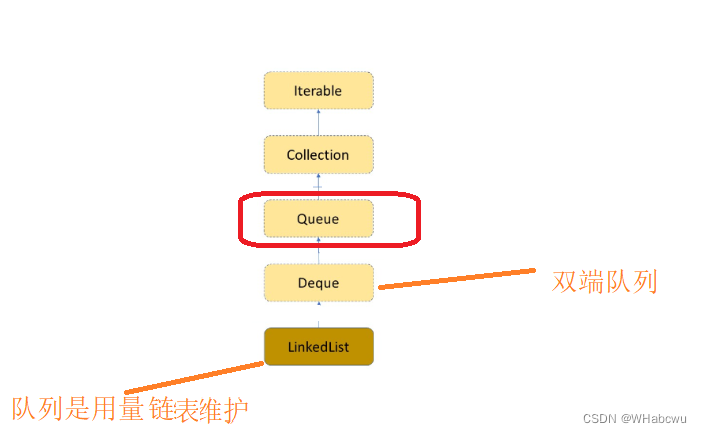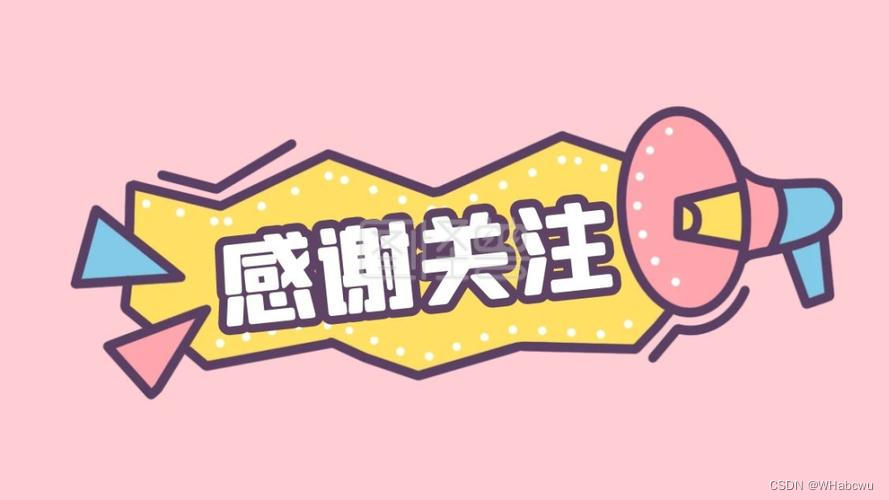目录
1.队列(Queue) 的概念
2.单链表模拟实现队列
2.1创建队列
2.2入队列
2.3判断是否为空
2.4出队列
2.5获取队头元素
2.6完整代码:
2.7双向链表模拟实现队列代码
3.数组模拟实现队列代码
3.1创建队列
3.2判断是否为满
3.3检查是否为空
3.4插入元素
3.5删除元素
3.6从队首获取元素
3.7 从队尾获取元素
4.双端队列 (Deque)
1.队列(Queue) 的概念


队列在使用时有以下方法:
 注意:Queue是个接口,在实例化时必须实例化LinkedList的对象,因为LinkedList实现了Queue接口。
注意:Queue是个接口,在实例化时必须实例化LinkedList的对象,因为LinkedList实现了Queue接口。
Queue<Integer> q = new LinkedList<>();
2.单链表模拟实现队列
2.1创建队列
代码:
public class Myqueue {class Node{public int val;public Node next;public Node(int val){this.val=val;}}public Node head;public Node last;public int size;
}2.2入队列
(1)创建一个节点node。
(2)判断该head是否为null,若为null,则该node就是head和last。
(3)若不为null,则 last.next=node, last=node;
(4)size++。
代码:
public void offer(int val){Node node = new Node(val);if(head==null){head=node;last=node;}else{last.next=node;last=node;}size++;}2.3判断是否为空
public boolean empty(){return size==0;}2.4出队列
(1)队列为空,则直接返回队列为空的异常。
自定义异常如下:
public class EmptyException extends RuntimeException{public EmptyException(String message) {super(message);}
}
(2)队列为空不为,先ret=head.val,后删除头结点。
(3)size--;
代码:
public int poll(){if(empty()){throw new EmptyException("队列为空");}int ret=head.val;head=head.next;size--;return ret;}2.5获取队头元素
代码:
public int peek(){if(empty()){throw new EmptyException("队列为空");}int ret=head.val;return ret;}2.6完整代码:
public class Myqueue {class Node{public int val;public Node next;public Node(int val){this.val=val;}}public Node head;public Node last;public int size;public void offer(int val){Node node = new Node(val);if(head==null){head=node;last=node;}else{last.next=node;last=node;}size++;}public int poll(){if(empty()){throw new EmptyException("队列为空");}int ret=head.val;head=head.next;size--;return ret;}public boolean empty(){return size==0;}public int peek(){if(empty()){throw new EmptyException("队列为空");}int ret=head.val;return ret;}
}2.7双向链表模拟实现队列代码
public class MyQueue {// 双向链表节点public static class ListNode {ListNode next;ListNode prev;int value;ListNode(int value) {this.value = value;}}ListNode first; // 队头ListNode last; // 队尾int size = 0;// 入队列---向双向链表位置插入新节点public void offer(int e) {ListNode newNode = new ListNode(e);if (first == null) {first = newNode;
// last = newNode;} else {last.next = newNode;newNode.prev = last;
// last = newNode;}last = newNode;size++;}// 出队列---将双向链表第一个节点删除掉public int poll() {
// 1. 队列为空
// 2. 队列中只有一个元素----链表中只有一个节点---直接删除
// 3. 队列中有多个元素---链表中有多个节点----将第一个节点删除int value = 0;if (first == null) {throw new EmptyException("队列为空");} else if (first == last) {last = null;first = null;} else {value = first.value;first = first.next;first.prev.next = null;first.prev = null;}--size;return value;}// 获取队头元素---获取链表中第一个节点的值域public int peek() {if (first == null) {throw new EmptyException("队列为空");}return first.value;}public int size() {return size;}public boolean isEmpty(){return first == null;}
}
3.数组模拟实现队列代码
实际中我们有时还会使用一种队列叫循环队列,环形队列通常使用数组实现。
循环队列![]() https://leetcode.cn/problems/design-circular-queue/description/描述:
https://leetcode.cn/problems/design-circular-queue/description/描述:



要解决循环队列的有如下几个难题:
(1)数组的下标如何实现循环
rear=(rear+1)%elem.length
front=(front+1)%elem.length
(2)区分空与满
有三个方法:
通过添加 size 属性记录
保留一个位置
使用标记
本博主采用第二个方法,如下图所示:

3.1创建队列
由于我们需要浪费一个空间来判断是否为满,在构造方法时多构造一个空间。
class MyCircularQueue {private int[] elem;private int front;//表示队列的头private int rear;//表示队列的尾public MyCircularQueue(int k) {this.elem=new int[k+1];}
}3.2判断是否为满
public boolean isFull() {return (rear+1)%elem.length==front;}3.3检查是否为空
public boolean isEmpty() {return rear == front;}3.4插入元素
(1)判断是否为满,若为满。返回false
(2)若不为满,则在elem下标为rear处插入该元素
(3)队尾向后走一步rear=(rear+1)%elem.length,返回true;
public boolean enQueue(int value) {if(isFull()){return false;}elem[rear]=value;rear=(rear+1)%elem.length;return true;}3.5删除元素
判断是否为null
(1)若为null。返回false
(2)若不为null,队首向后走一步 front = (front+1)%elem.length;,返回true;
public boolean deQueue() {if (isEmpty()){return false;}front = (front+1)%elem.length;return true;}
3.6从队首获取元素
public int Front(){if(isEmpty()){return -1;}return elem[front];}3.7 从队尾获取元素
(1)如果队列为空,返回-1
(2)不为空,如果为队尾下标为0,返回下elem[elem.length-1]的值
(3)下标不为0,返回数组下标为rear-1的值
public int Rear() {if(isEmpty() ) {return -1;}if(rear == 0) {return elem[elem.length-1];}return elem[rear-1];}3.8完整代码
class MyCircularQueue {private int[] elem;private int front;//表示队列的头private int rear;//表示队列的尾public MyCircularQueue(int k) {this.elem = new int[k + 1];}public boolean enQueue(int value) {if (isFull()) {return false;}elem[rear] = value;rear = (rear + 1) % elem.length;return true;}public boolean deQueue() {if (isEmpty()){return false;}front = (front+1)%elem.length;return true;}//从队首获取元素。如果队列为空,返回 -1 。public int Front() {if(isEmpty() ) {return -1;}return elem[front];}//从队尾获取元素。如果队列为空,返回 -1 。public int Rear() {if(isEmpty() ) {return -1;}if(rear == 0) {return elem[elem.length-1];}return elem[rear-1];}//检查循环队列是否为空。public boolean isEmpty() {return rear == front;}public boolean isFull() {return (rear + 1) % elem.length == front;}
}4.双端队列 (Deque)
Deque是一个接口,使用时必须创建LinkedList的对象。

在实际工程中,使用Deque接口是比较多的,栈和队列均可以使用该接口
Deque<Integer> stack = new ArrayDeque<>();//双端队列的线性实现
Deque<Integer> queue = new LinkedList<>();//双端队列的链式实现
以上为我个人的小分享,如有问题,欢迎讨论!!!
都看到这了,不如关注一下,给个免费的赞 ![]()




![[Java]_[初级]_[以SAX流的方式高效读取XML大文件]](http://pic.xiahunao.cn/[Java]_[初级]_[以SAX流的方式高效读取XML大文件])

)

)





9.1更新内容)



--- 常用前后端框架)

